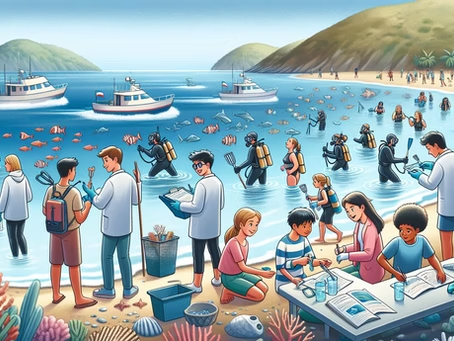Introduction
Citizen science has emerged as a transformative force in marine conservation. By inviting public participation, it bridges the gap between science and society, empowering individuals to collect data, share knowledge, and advocate for ocean protection. This partnership fosters environmental stewardship, strengthens community resilience, and enhances scientific understanding of marine ecosystems.
Diving into Citizen Science
Defining Citizen Science
At its core, citizen science is public involvement in research. Volunteers gather and analyze data, expanding the reach of science beyond laboratories. Also called community science, it emphasizes collective effort and democratizes knowledge, ensuring that science becomes more accessible and impactful.
The Rise of Public Participation
The participatory turn in science reflects growing demand for transparency and inclusivity. Communities, scientists, and organizations collaborate to address local and global challenges. This shift boosts scientific literacy, fosters ownership, and ensures that research responds to real-world needs.
Key Components of Success
- Shared Responsibility: Projects thrive when communities and researchers jointly guide goals.
- Equitable Processes: Inclusive decision-making builds trust and broadens participation.
- Cultural Sensitivity: Respecting traditions enhances cooperation and relevance.
Community Involvement in Marine Conservation
Local Actions, Global Impact
Community-driven initiatives, from beach cleanups to local monitoring, ripple outward to influence global conservation. Data collected locally can shape international policy, while grassroots education inspires replication in other regions.
Case Studies
Projects like the Green Duwamish Learning Landscape show how community priorities, shared leadership, and agency partnerships sustain long-term conservation. These models highlight the power of collaboration in protecting marine ecosystems.
Education as a Catalyst
Workshops and Seminars
Educational programs make marine science accessible through lectures, field trips, and interactive activities. They not only transfer knowledge but also spark advocacy and action among participants.
Creating a Ripple Effect
Education transforms individuals into advocates. One informed person can inspire many others, generating a movement rooted in awareness, action, and policy influence.
The Power of Data
From Observation to Contribution
Beachcombing, wildlife sightings, and water monitoring are no longer casual hobbies—they are structured data contributions. Citizen scientists help fill research gaps, especially in remote or understudied areas.
Ensuring Data Quality
- Training: Clear protocols and hands-on practice ensure reliability.
- Validation: Professional review enhances credibility.
- Feedback: Ongoing communication keeps participants motivated and informed.
Collaboration Between Scientists and Citizens
Co-Creation in Research
When citizens and scientists share leadership, projects align more closely with both academic goals and community needs. This creates research that is inclusive, practical, and impactful.
Building Trust
Transparency, open communication, and shared decision-making establish credibility and strengthen partnerships. Every participant becomes a valued contributor to marine conservation.
Youth Engagement
Inspiring Young Stewards
Interactive education programs immerse young people in conservation, sparking lifelong connections to marine ecosystems. Fieldwork, group projects, and mentorship transform students into advocates and future scientists.
Long-Term Benefits
By involving youth, conservation builds future leaders who influence communities, pursue careers in marine science, and drive sustainability movements.
Technology and Innovation
Mobile Apps and Online Platforms
Digital tools make data collection simple and accessible. Real-time reporting connects citizen scientists worldwide, creating networks of engaged ocean advocates.
Remote Sensing Synergy
Satellites and drones provide large-scale data, while citizens offer local ground-truth observations. Together, these approaches create a more complete understanding of marine ecosystems.
Navigating Challenges
Overcoming Misinformation
Workshops, transparent reporting, and verification protocols help combat skepticism and misinformation, ensuring credibility.
Balancing Rigor and Participation
Training and inclusive project design maintain scientific standards while encouraging broad public engagement.
Funding Constraints
Creative funding solutions, long-term partnerships, and flexible project structures sustain citizen science despite limited resources.
The Social Side of Science
Building Networks
Strong community networks connect citizens, organizations, and experts. These relationships create coordinated conservation strategies and amplify impact.
Sustaining Engagement
- Set clear, shared goals
- Celebrate small victories
- Provide training and growth opportunities
The Future of Citizen Science
Scaling Up
Local projects can grow into global movements by aligning efforts through collective impact frameworks, shared data, and international collaboration.
The Evolving Role of Citizen Scientists
No longer just data collectors, citizen scientists are becoming advocates, co-creators, and community leaders in marine conservation.
Conclusion
Citizen science and marine conservation are deeply intertwined. By merging public participation with professional research, we create stronger data, deeper connections, and more resilient oceans. With education, technology, and collaboration, citizen science will continue to shape the future of marine conservation worldwide.

